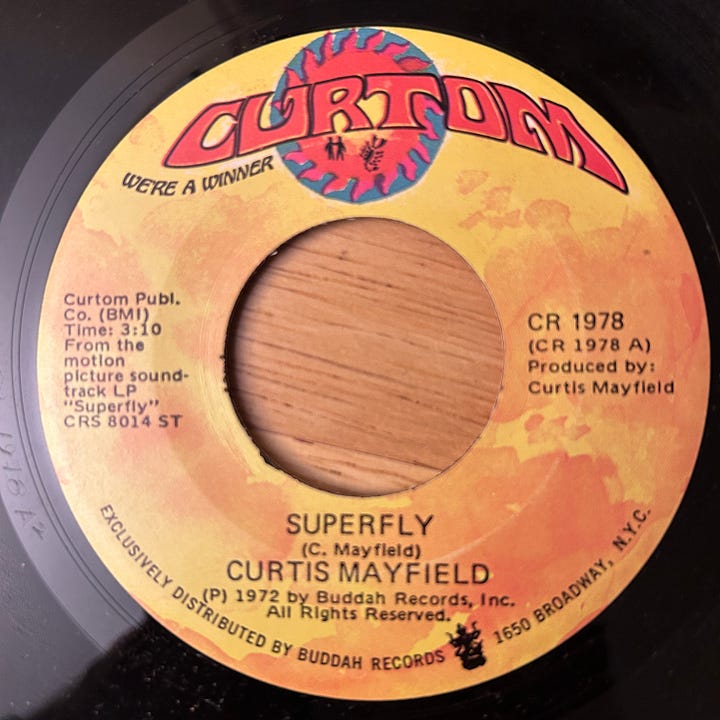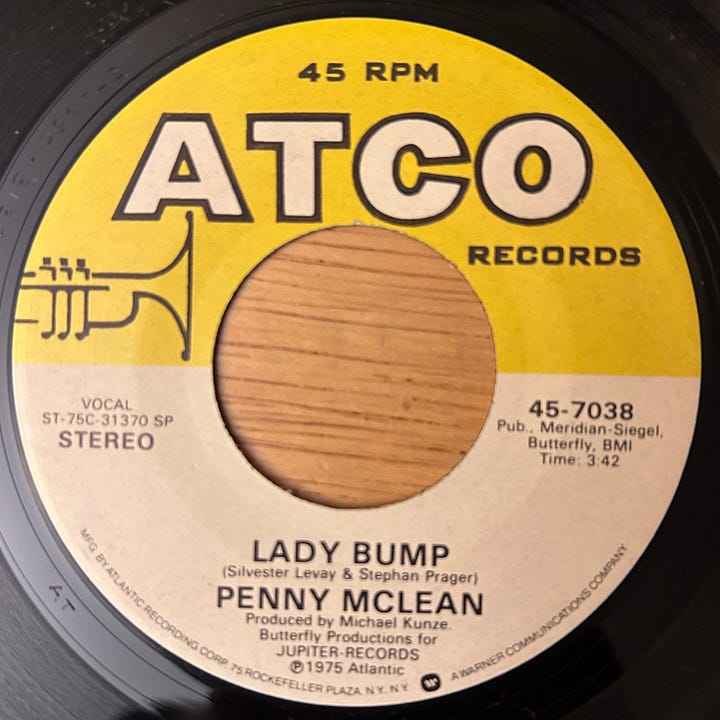

Jagged Time Lapse is a reader-supported publication. To receive new posts via email and support my work, please consider becoming a free or (better yet!) paid subscriber. Click here to subscribe for free, or to upgrade your JTL subscription to paid. Thanks!
A few weeks back, I splurged and bought a ridiculously large — like, 50 boxes large — collection of old 45s from a friend of a friend. I knew going in that there would probably be a high landfill percentage happening, but estimated that there would also be enough tasty surprises lurking within to make it worth the expenditure. So far, that estimation has proved correct.
I’ve been slowing working my way through the boxes ever since. On Sunday night, while digging through a box comprised entirely of “M” artists, I unearthed the two apparently unplayed singles you see above, which pretty much hail from the sublime and ridiculous ends of the seventies pop spectrum, respectively.
The Curtis Mayfield pull was well-timed, because yesterday would have been the late Chicago soul legend’s 82nd birthday. I’ve ranted before (like in this JTL piece on The Five Stairsteps) about how Chicago has gone all-in on its blues legacy while badly neglecting the city’s incredible soul and R&B legacy, and how sad it is that Curtis — one of the greatest songwriters ever to emerge from the Windy City — has only been half-assedly memorialized there with a chintzy street sign instead of the statue he deserves. I’ll spare you further bilious brayings along those lines, and just say that Curtis Mayfield’s music and lyrics have done more to prop up my sagging faith in humanity over this past decade than those of any artist I can think of. Here’s to your sweet, visionary and love-filled spirit, Curtis, wherever it now resides…
In honor of Curtis’s birthday, and of finding that super-fly “Superfly” 45 — not a hard seven-inch to come across, though I rarely see copies as clean as this one — here’s some fantastic 1972 live footage of him and his band performing “Superfly”.
From the opposite end of the sublime/ridiculous spectrum comes Penny McLean’s 1975 hit “Lady Bump”. A Top 10 disco smash throughout Europe — though it only made it to #48 in the States — the song cashed in big on the “Bump” dance craze of the time. The Austrian singer, who was born Gertrude Wirschinger, was also a member of Silver Convention, whose “Fly Robin Fly” still looms large in my childhood memories. Sylvester Levay and Stephan Prager, the same songwriters behind Silver Convention, were responsible for “Lady Bump,” a song most notable for its novel use of a blood-curdling shriek as a chorus hook.
Seriously, the first time I ever heard “Lady Bump” (on Sirius XM’s Studio 54 channel, nearly 40 years after its original release), I was so startled by Ms. McLean’s unexpected screech that I nearly ran my car off L.A.’s Beverly Boulevard and into an innocent sidewalk churro stand. It seriously sounds like she’s being stabbed, or has just opened the door to a locked room in her husband’s ancestral manse and been confronted by the horribly deformed cousin that his family never talks about. That same Hammer Horror vibe colors her menacing delivery of the line, “Look at me and you’ll know why” — the first time I saw the video below, I half-expected the cameraman to suddenly zoom in on her face, revealing a horrific expanse of bumps and pustules. (“Look at me, if you dare! LOOK AT ME!!!”)
“Lady Bump” has long been a running in-joke for me and several of my friends, but it was only upon finding the 45 of it the other night that I learned there was more to the story — namely, a B-side called “The Lady Bumps On”. Basically a remixed “Lady Bump” backing track, “The Lady Bumps On” dispenses with McLean’s lead vocal but keeps her disembodied screams, which makes them sound both even more frightening and even more absurd.
And speaking of absurd…
While searching YouTube yesterday for “The Lady Bumps On,” I came across this mid-blowing McLean song and clip, which was apparently considered as an entry for Luxembourg in the 1979 Eurovision Song Contest. It was not accepted, however, possibly because it was deemed too idiotic even for Eurovision.
As someone who’s been deeply into Egyptology since his teens, I know I should be annoyed/appalled by a song whose lyrics are so inane as to make Steve Martin’s “King Tut” sound like a PBS documentary… but I simply cannot resist “Tut-Ench-Amun”’s giddy disco-schlock charms, or Ms. Wirschinger’s preposterous (yet still rather fetching) “Egyptian” costume. “Tut-Ench-Amun” may not quite be a disco history lesson on the level of Boney M’s immortal “Rasputin,” but I’m still glad it exists — and I’m really hoping a copy will turn up in one of the many boxes I have yet to comb through.




Curtis wasn't the only soul man who lived in Cabrini Green- so did Jerry Butler, Gene Chandler and Major Lance. Curtis played a prominent role in all of their careers.
Chicago definitely hasn't done right by Mayfield. In the downtown area, there are a lot of streets named after local celebrities, but I didn't see anything like "Curtis Mayfield Way".
In the '60s and '70s the Windy City produced many classic hits rivaling those coming out of Motown, Stax and Philadelphia International, and it seemed like Mayfield wrote the vast majority of them, done by his group The Impressions, him as a solo artist, or for the artists he had on the roster on his Curtom label. The guy was amazingly prolific as a writer!
The problem was that there was never a label in the city that rivalled the staying power of the R&B powerhouses in other cities. Vee-Jay and Curtom both only lasted a decade or so, and there were many others that came and went quickly, Chess had some good soul artists but they tended to treat them as secondary to the blues crowd. And the largest independent label in the city, Mercury, which had once had a strong R&B and jazz roster, ended up being swallowed up by foreign ownership that ultimately to it (along with Motown) being merely part of Universal Music now.